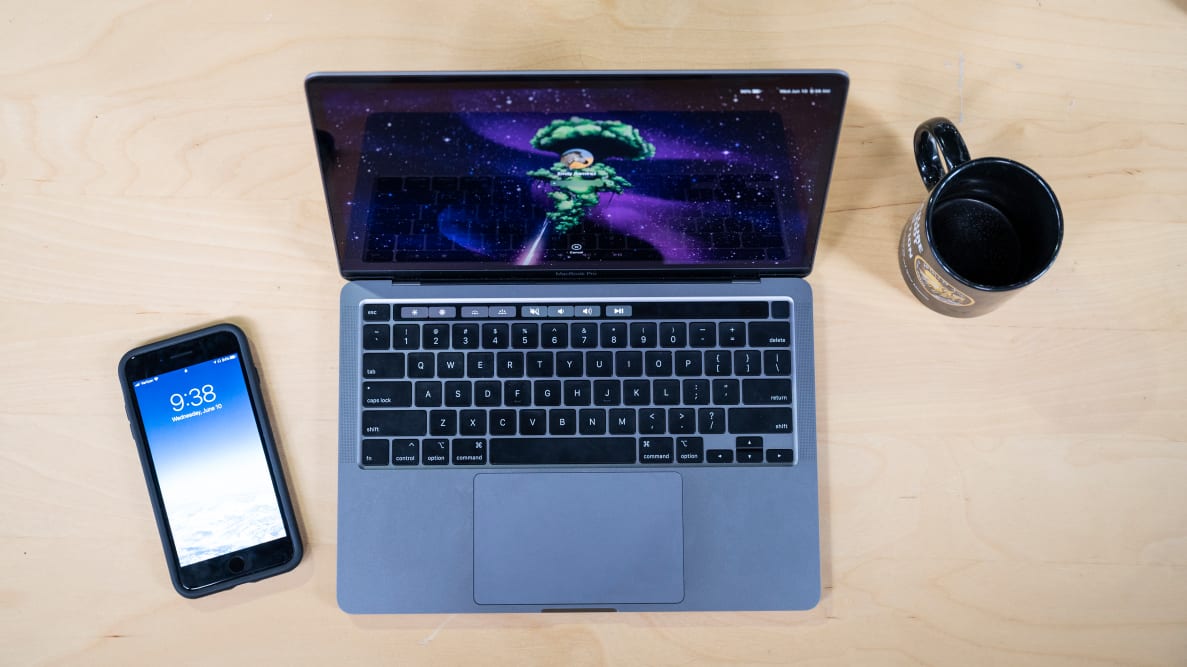Pros
-
Loud speakers
-
Powerful
Cons
-
Gets hot when running demanding tasks
-
Expensive
The 13-inch Macbook Pro has consistently proven itself as a portable machine for prosumers and creatives who need to run powerful applications. This time, the 2020 version comes with the Magic Keyboard, which means that no longer will we be at the mercy of the Butterfly Keyboard, the traitorous oaf that was infamous for breaking when you needed to type anything of import.
While the cheaper configurations of the 13-inch Macbook Pro are good enough for Photoshop, they are relatively under-powered for what you expect out of a Macbook Pro. They are only marginally more powerful than a similarly priced Macbook Air, and for $1,299 the Air comes with newer processors than the $1,299 13-inch Pro. Unless you can shell out $1,800 or more for a Macbook Pro with 10th-gen Intel Processors, you won’t be getting a worthwhile upgrade. If you want a cheaper Macbook, the Macbook Air is a much better value than either of the cheaper Macbook Pro configurations. If you’re willing to consider Windows, many laptops, like the Dell XPS 13 or the HP Spectre x360, offer not just the same hardware as the $1,800+ Macbook Pro configurations but also discrete graphics cards—often for much cheaper.
About the 2020 13-inch Macbook Pro
The 13 inch Macbook Pro is the happy medium between the ultraportable Macbook Air and the ultra-powerful 16-inch Macbook Pro. While the 13-inch model does not pack a discrete GPU or offer processors as powerful as those found on the 16-inch model, it still delivers plenty of performance for photo and video editing.
While the base model starts at $1,199, our test model is a $1,999 configuration. These are the specs for our model, with the possible customizations listed in parentheses:
- Processor: 10th-gen 2.3GHz quad-core Intel Core i7 (8th- and 10th-gen Intel Core i5 also available)
- Memory: 16GB 3733MHz LPDDR4X RAM (8GB 2133MHZ LDDR3 memory also available)
- Storage: 512GB SSD (256GB to 4TB configurations available)
- Display: 13.3-inch 2560x1600p Retina LED display with True Tone
- Ports: Thunderbolt 3 USB-C (x4), headphone jack
- Touchpad: Force Touch trackpad
- Graphics: Intel Iris Plus Graphics (integrated)
- Wireless: 802.11ac Wi-Fi and Bluetooth 5.0
- Battery: 58.0WHr Lithium-polymer battery
- Charger: 61W AC Adapter, USB-C
- Weight: 3.1lbs
- Dimensions: 11.97 x 0.61 x 8.36 inches (W x H x D)
- Warranty: 1-year limited warranty, 90 days tech support.
What We Like
Finally, a Typist's Dream Keyboard
Once Apple released the updated 16-inch Macbook Pro in 2019, we were left thirsting for a more portable workhorse that had a usable keyboard.
We’ve talked about it before, but we are ecstatic that the Butterfly keyboard is gone. If you’ve typed on a pre-2016 Macbook, you’re probably familiar with the soft yet tactile chiclet keys that made the Macbook keyboards so universally loved. Thankfully, the Magic keyboard feels very similar to the old Macbooks. By comparison to the classic scissor switch keys, the Magic keys are slightly shallower and require a bit more force to type on in order to simulate that beloved tactile feel. Travelling across the keyboard feels incredibly smooth, and I seldom pressed a key by accident. Once again, the Macbook Pro can proudly stand against the best Windows keyboards out there.
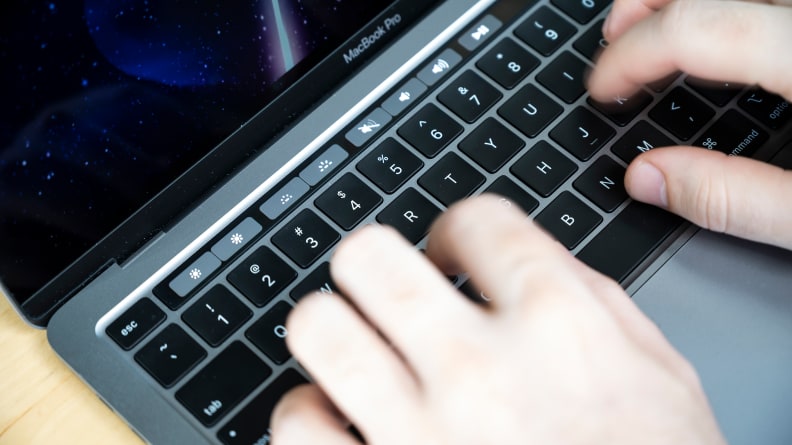
The new Magic Keyboard breathes new life into the 13-inch Macbook Pro line.
It can handle serious work on the daily—for the most part
If you’re always on the move and you need power to edit videos, write complex code, or just want to know your machine is future proof for the next five years, you can upgrade the 13-inch Pro all the way up to a 10th generation Intel Core i7 processor, 32GB of blazing fast DDR4 RAM, and a 4 TB SSD. Unless you plan to do graphics-intensive work on your laptop—and if you are, please look at the 16-inch Pro, instead—the 13-inch Pro can more than handle serious tasks.
When we tested our Macbook Pro, it performed as expected for its configuration: quickly and smoothly, unless you needed graphics-intensive processing. In our benchmark testing, we saw the laptop score 1268 on Geekbench 5's single core test. For reference, our Dell XPS 15 with a 9th gen Intel Core i9 processor and a nVidia GeForce GTX 1650 discrete graphics card achieved 1215 on Geekbench 5.
The Macbook Pro really struggled with multi-core benchmarking, scoring a paltry 1857 on Cinebench and 4720 on Geekbench’s multi core test. The Dell XPS 15 crushed the Macbook Pro, scoring 2617 on Cinebench and 6534 on Geekbench 5's multi-core testing. If you plan to use your Macbook Pro for heavy multithreading applications, such as machine learning or simultaneously running After Effects and Logic Pro, you may find the Macbook Pro struggles in comparison to a machine more purpose-built for these tasks.
Meanwhile, the 13-inch Macbook Pro’s integrated Intel Iris graphics processor can't compete with discrete GPUs. In the video game Shadow of the Tomb Raider, we managed to squeeze just 6 frames per second out of the Intel Iris when playing the game on the highest graphics settings. By comparison, the discrete GPU on the Dell XPS 15 (the nVidia GeForce GT 1650) churned out 52 frames per second, i.e. something that’s playable. In Basemark, a web-based javascript test, the Macbook Pro fared better, scoring 884.39 while the Dell XPS actually scored a much lower 670.86. While you reasonably can’t expect to play big-title games on the 13-inch Macbook Pro, you’ll be alright for light to medium-graphics processing, like a small web interactive rendered in real time.
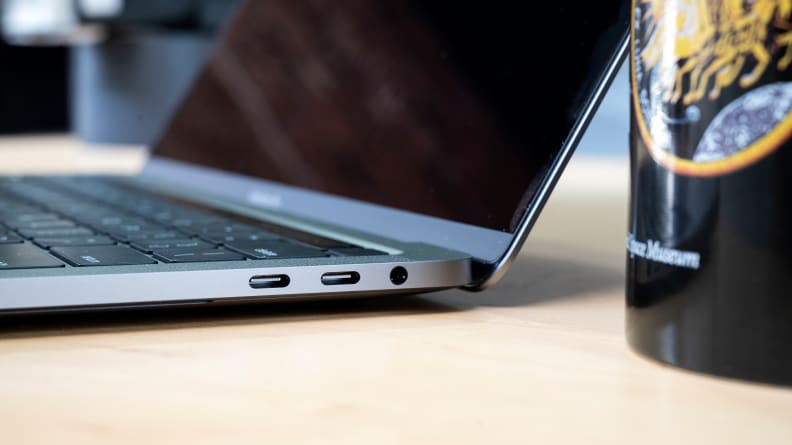
The $1,799 and $1,999 Macbook Pro builds have 4 Thunderbolt ports and a headphone jack.
At $1,299, the base 13-inch Pro includes an 8th generation Intel Core i5 processor, 8 GB DDR3 RAM and a 256 GB SSD. While the hardware feels extremely outdated for a brand new 2020 laptop model, it is technically powerful enough to accomplish moderately intensive tasks. By comparison, a Dell XPS 13 with a 10th-gen Intel Core i5 processor, 8GB of the faster 3733 MHz DDR4 Memory, and a 256GB SSD is just $1,149. If you’re looking for an everyday machine for simpler work, such as browsing the web, your wallet will be disappointed with the base 13-inch Macbook Pro.
We’re glad Apple kept these features
Although it’s a new Macbook, it comes with the now 4-year-old Touch Bar and the beautiful Retina display that’s been standard on Pros for years. It still has that classic, premium aluminum body that makes you feel fashionably techy. Its speakers are better than ever, with a satisfyingly detailed sound that’s loud enough to hear in a loud kitchen.
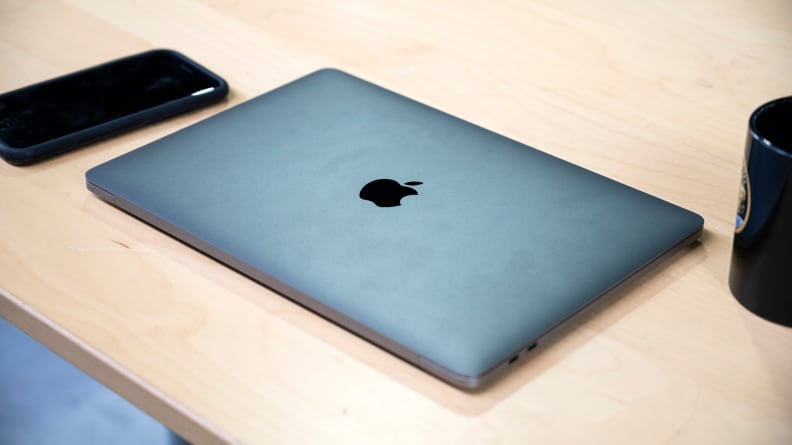
The 2020 model's looks are as stylish as ever, with rigid aluminum construction and an ultra-thin chassis.
The 13-inch Pro’s battery life is still as good as its predecessors’, standing at 10 hours of battery life according to Apple and clocking a little over 7 hours and 8 minutes in our Chrome web test. For reference, our comparably specced Dell XPS 15 lasted 6 hours. In my casual use of our Pro, I’ve been averaging anywhere from 8 to 12 hours of battery life.
Its Retina display is crisp and bright, with whites getting up to 450 nits of brightness and blacks getting as low as 0.03 nits. That translates to dark shadows and bright, vivid highlights that can be seen on a sunny patio. While the display is not as high-resolution as some popular 4k laptops, the Retina display still looks detailed and easy to read. The Pro also ships with its colors pre-calibrated for excellent color accuracy, which is great for photo editors.
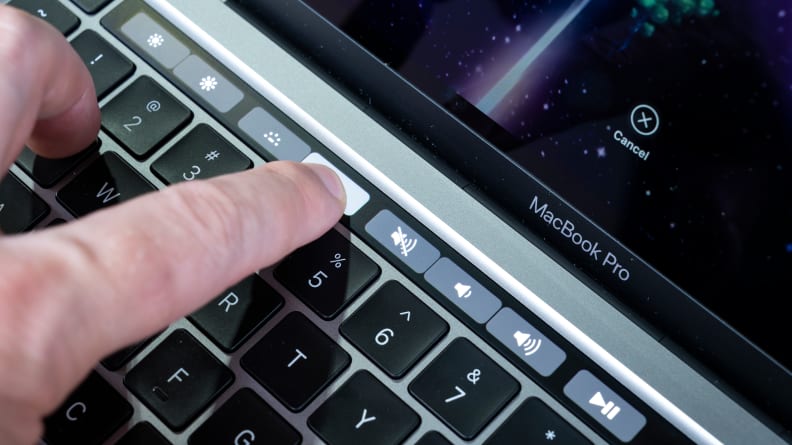
All 2020 models come with a Touch Bar, which acts like a mini-control hub for many apps and device functions.
What We Don’t Like
There's an upgrade tax
The 2020 model feels like a big upgrade over the 2019 model…if you get an $1,800+ configuration. Both of the lower end configurations have an old, much slower style of system memory called DDR3, older processors, and two thunderbolt ports as opposed to the more expensive models’ four thunderbolt ports. Additionally, they only come with 8GB of DDR3 RAM. By comparison, many Windows laptops in the $1,000-$1,500 range have 16GB of DDR4 RAM, 10th generation Intel Core i5/i7 processors (or their AMD equivalents), and in some cases even touchscreens and 4K screens. Considering the competition, it feels disingenuous of Apple to offer such poorly specced systems for so much more money than the Macbook Air—DDR4 RAM should be standard across all Macbooks, as it’s been around for 6 years and DDR5 RAM is possibly months away from launching.
However, I do want to be clear: while the two lower end Macbook Pros are not exactly future-proof, they are not weak machines, either. They are powerful enough to run Photoshop, for example, but their poor specs call into question why a potential customer would choose one of these Macbook Pros over the cheaper, more power-efficient Macbook Air lineup.
On the other end of the configuration spectrum, Apple does not offer a 13-inch Macbook Pro with an Intel Core i9 processor or a discrete graphics card. If you need something ultra-powerful, you have to buy the bulkier 16-inch Macbook Pro instead.
Potential Heating Issues
Even though the 2020 model is slightly cooler than the 2019 model, its lackluster cooling still leaves room for improvement. If you're planning on browsing the web, expect to see a temp of about 90 degrees on the outside. The Macbook Pro probably won’t fry your lap while you check your emails, but it easily reached internal temperatures over 90℃ when performing intense tasks over a sustained period of time. It is still reporting better temperatures than the 2019 model, but such high heat can strain the system’s performance and shorten the laptop’s lifespan significantly.
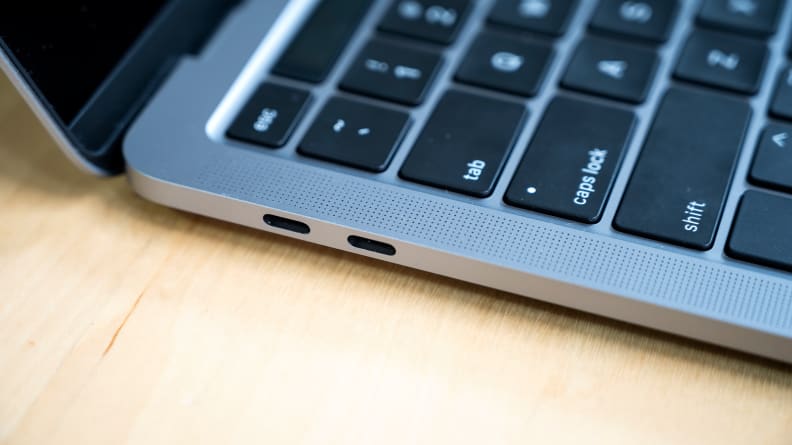
The $1,299 and $1,499 configurations of the 13-inch Macbook Pro only have 2 Thunderbolt ports and the same processors as the 2019 models.
Should You Buy It
The 2020 13-inch Macbook Pro is not a good value, but it's a smooth MacOS experience.
Thanks to the new Magic Keyboard and its upgraded internals, the 2020 13-inch Macbook Pro is what we expected for those who need a powerful, reliable machine to do serious creative work...if you get one of the more expensive 10th-gen Intel Core i5 configurations, which will run you at least $1,799. Meanwhile, the cheaper configurations feel like a side-grade from the 2019 models, with the only real updates being the Magic Keyboard, a physical Escape key, and a Touch Bar.
If you’re choosing between the Air and the under-$1,800 13-inch Macbook Pro configurations, there is little reason to choose the Macbook Pro. For the regular person who’s shopping for a new laptop for browsing, emails, Netflix, and the occasional photo-editing, the 2020 Macbook Air is a fantastic laptop that will satisfy most peoples’ needs—and it starts at $999. While the Macbook Pro has somewhat more powerful processors, the Macbook Air has slightly better battery life and is a better bang for your buck.
Should you be open to using Windows 10, you may also want to take a look at the HP Spectre x360 or the Dell XPS 13. The Spectre x360 is a premium 2-in-1 laptop that not only performs head-to-head with the Macbook Pro, but also competes in the looks and feels department. For only $1,269.99, you can get a Spectre with a 10th-gen Intel Core i7 processor, 16GB DDR4 RAM, and a 512GB SSD (a similar Macbook Pro costs $1,999). When one of our editors reviewed this laptop, he loved it.
The Dell XPS 13 is another amazing laptop, which has been a suave favorite among power users for years thanks to its excellent keyboard, its flexible hardware configurations, and its excellent build quality. For a fully decked out XPS with a 10th-gen Core i7, 16GB DDR4 RAM, a 512 GB SSD and a 4K screen for $1,861.99—still cheaper than the comparable $1,999 Macbook Pro, and it has a better screen.
If you have money to burn and feel the Macbook Pro is the best choice for you, I’d suggest getting a $1,799 configuration with a 10th gen Intel Core-i5 Processor, 16GB of DDR4 RAM, and 512GB of storage, since you can’t upgrade your Macbook’s specs later on. The $1,799 model comes with two more Thunderbolt ports, more power, and enough speed to last you at least 4 to 5 years before you need to upgrade. The Macbook Pro is doubtlessly a pleasure to use, but that pleasure will cost you dearly.
Meet the tester
Adrien has over 4 years of experience covering laptops, desktops, software, games, and more.
Checking our work.
Our team is here to help you buy the best stuff and love what you own. Our writers, editors, and experts obsess over the products we cover to make sure you're confident and satisfied. Have a different opinion about something we recommend? Email us and we'll compare notes.
Shoot us an email